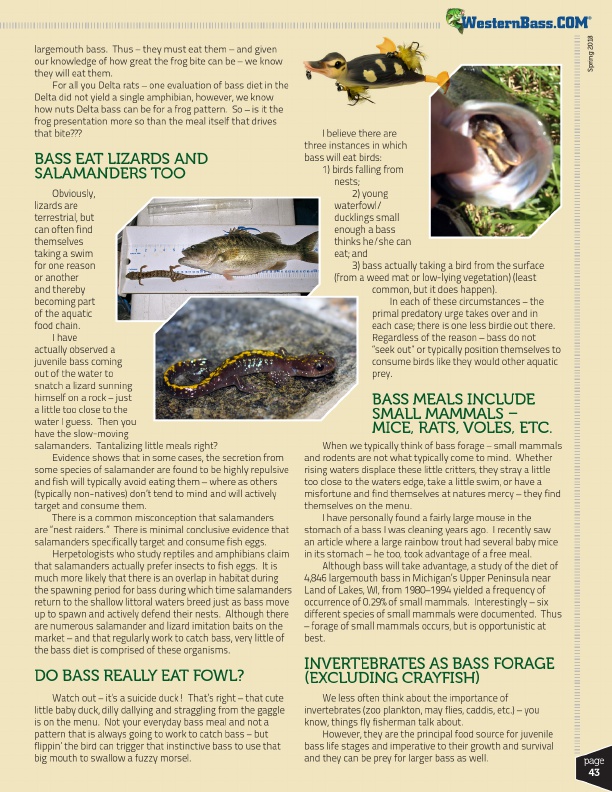
®
largemouth bass. Thus – they must eat them – and given our knowledge of how great the frog bite can be – we know they will eat them.
For all you Delta rats – one evaluation of bass diet in the Delta did not yield a single amphibian, however, we know how nuts Delta bass can be for a frog pattern. So – is it the frog presentation more so than the meal itself that drives that bite???
BASS EAT LIZARDS AND SALAMANDERS TOO
Obviously, lizards are terrestrial, but can often find themselves taking a swim for one reason or another and thereby becoming part of the aquatic food chain.
I have actually observed a juvenile bass coming out of the water to snatch a lizard sunning himself on a rock – just a little too close to the water I guess. Then you have the slow-moving salamanders. Tantalizing little meals right?
Evidence shows that in some cases, the secretion from some species of salamander are found to be highly repulsive and fish will typically avoid eating them – where as others (typically non-natives) don’t tend to mind and will actively target and consume them.
There is a common misconception that salamanders are “nest raiders.” There is minimal conclusive evidence that salamanders specifically target and consume fish eggs.
Herpetologists who study reptiles and amphibians claim that salamanders actually prefer insects to fish eggs. It is much more likely that there is an overlap in habitat during the spawning period for bass during which time salamanders return to the shallow littoral waters breed just as bass move up to spawn and actively defend their nests. Although there are numerous salamander and lizard imitation baits on the market – and that regularly work to catch bass, very little of the bass diet is comprised of these organisms.
DO BASS REALLY EAT FOWL?
Watch out – it’s a suicide duck! That’s right – that cute little baby duck, dilly dallying and straggling from the gaggle is on the menu. Not your everyday bass meal and not a pattern that is always going to work to catch bass – but flippin’ the bird can trigger that instinctive bass to use that big mouth to swallow a fuzzy morsel.
I believe there are three instances in which bass will eat birds:
1) birds falling from
nests;
2) young
waterfowl/
ducklings small
enough a bass
thinks he/she can
eat; and
3) bass actually taking a bird from the surface
(from a weed mat or low-lying vegetation) (least
common, but it does happen).
In each of these circumstances – the
primal predatory urge takes over and in
each case; there is one less birdie out there.
Regardless of the reason – bass do not
“seek out” or typically position themselves to
consume birds like they would other aquatic
prey.
BASS MEALS INCLUDE SMALL MAMMALS – MICE, RATS, VOLES, ETC.
When we typically think of bass forage – small mammals and rodents are not what typically come to mind. Whether rising waters displace these little critters, they stray a little too close to the waters edge, take a little swim, or have a misfortune and find themselves at natures mercy – they find themselves on the menu.
I have personally found a fairly large mouse in the stomach of a bass I was cleaning years ago. I recently saw an article where a large rainbow trout had several baby mice in its stomach – he too, took advantage of a free meal.
Although bass will take advantage, a study of the diet of 4,846 largemouth bass in Michigan’s Upper Peninsula near Land of Lakes, WI, from 1980–1994 yielded a frequency of occurrence of 0.29% of small mammals. Interestingly – six different species of small mammals were documented. Thus – forage of small mammals occurs, but is opportunistic at best.
INVERTEBRATES AS BASS FORAGE (EXCLUDING CRAYFISH)
We less often think about the importance of invertebrates (zoo plankton, may flies, caddis, etc.) – you know, things fly fisherman talk about.
However, they are the principal food source for juvenile bass life stages and imperative to their growth and survival and they can be prey for larger bass as well.
Spring 2018
page 43